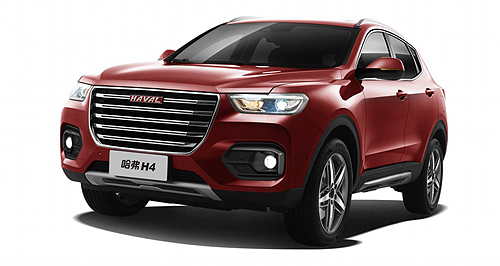Make / Model Search
Future models - Haval - H4Haval keen for H4 Australian debutIn betweenie: If the recently-revealed H4 makes it to Australian shores, the stylish high-rider would bolster Haval’s local line-up that includes the H2 small crossover, H6 mid-sizer, H8 and H9 large SUVs. H4 remains LHD-only, but Haval Australia eager to sell new mid-size SUV hereGallery Click to see larger images 5 Apr 2018 By TUNG NGUYEN HAVAL’S just-revealed H4 mid-size SUV will be launched in its home market of China this year, but the Chinese brand’s Australian division is keen to get the new crossover vehicle into local showrooms to bolster the burgeoning marque’s line-up. Haval Motors Australia public relations and product planning manager Andrew Ellis told GoAuto that the H4 was slated to be produced only in left-hand drive, but that if a suitable H4 were to materialise, “we’d be at the front of the queue”. “At the moment, (the H4 is) left-hand-drive production only, but … we really want this in right-hand drive,” he said. “When we saw the concept two years ago, we said ‘this is beautiful’ – the concept is stunning and this is pretty true to the concept.” If the H4 was added to Haval’s Australian line-up, it would slot in above the H2 small SUV and below the H6 as a smaller mid-size crossover. Measuring 4420mm ling, 1845mm wide, 1695mm tall and with a 26600mm wheelbase, the H4 just scrapes into the mid-size crossover segment and could compete directly against the likes of the dominating Mazda CX-5, Hyundai Tucson, Toyota RAV4, Volkswagen Tiguan, Subaru Forester, Ford Escape and Holden Equinox. For reference, the H6 is 129mm longer, 5mm taller and features a 120mm extended wheelbase, but the H4 is 5mm wider. Powered by either a 1.3- or 1.5-litre turbocharged engine, the Haval H4 produces 102kW/225Nm in the smaller capacity engine or 124kW/285Nm in the larger displacement unit. Both drivetrains will send power the ground via a seven-speed dual-clutch automatic gearbox, but Haval has yet to reveal if the H4 will be two-wheel- or all-wheel-drive, or a combination of both. Mr Ellis told GoAuto that the larger 1.5-litre engine could proliferate across Haval’s SUV range, appearing next under the bonnet of the H6 mid-size SUV that currently employs a 145kW/315NM 2.0-litre turbocharged four cylinder. “Speaking to the Chinese, they said the 1.5 (litre engine) is an absolute gem,” he said. “That’s the engine we want going forward.” The H4 is based on the HR-02 concept revealed at Auto China 2016. That was penned under the reign of Haval design chief and former BMW stylist Pierre LeClercq before he quit the company to join Hyundai. The H4 sports softer lines and a smoother design compared with its stablemates, and features a prominent five-slot grille proudly up front. Integrated roof rails, black plastic wheel-arch cladding, chunky side steps and contrasting front bash plate hint at the H4’s high-riding credentials. From the driver’s seat, an all-digital instrument cluster can be glimpsed, as well as a floating 12.0-inch infotainment screen with smartphone mirroring capabilities. Other features include a 360-degree surround view camera system, as well as safety features including lane departure warning, lane change assist, tyre pressure monitoring, and front and rear parking sensors, while Haval’s Connected telematics suite bundles emergency rescue, security monitoring and remote vehicle diagnosis.  Read more29th of January 2018  Haval lays bare three-year planHybrid, electric powertrains to make up 30 per cent of Haval Australia sales by 202223rd of November 2017  Guangzhou show: Great Wall plugs inWey P8’s hybrid tech could point the way for Haval’s plug-in futureAll future modelsMotor industry news |
Click to shareHaval modelsAll future modelsMotor industry news |









 Alfa Romeo
Alfa Romeo Abarth
Abarth Audi
Audi Aston Martin
Aston Martin BMW
BMW Bentley
Bentley Ferrari
Ferrari Chevrolet
Chevrolet Ford
Ford Fiat
Fiat GWM
GWM Foton
Foton Hyundai
Hyundai Honda
Honda Jaguar
Jaguar Isuzu
Isuzu Kia
Kia Jeep
Jeep Land Rover
Land Rover Lamborghini
Lamborghini Maserati
Maserati Lexus
Lexus McLaren
McLaren Mazda
Mazda Mercedes-Benz
Mercedes-Benz Mitsubishi
Mitsubishi Mini
Mini Peugeot
Peugeot Nissan
Nissan Ram
Ram Porsche
Porsche Rolls-Royce
Rolls-Royce Smart
Smart Skoda
Skoda Suzuki
Suzuki Subaru
Subaru Toyota
Toyota Tesla
Tesla Volvo
Volvo Zeekr
Zeekr







Facebook Twitter Instagram